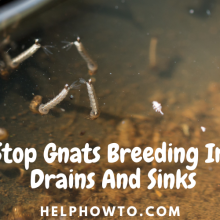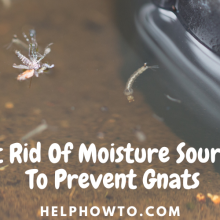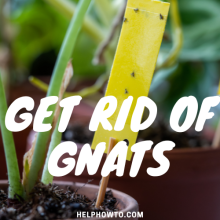How To Stop Gnats From Breeding In Houseplants | HelpHowTo
Summary of Answering How To Stop Gnats From Breeding In Houseplants
Fungus gnats are tiny flies that infest houseplants by laying eggs in the potting soil, where the larvae feed on roots and fungi. Signs of infestation include flying adult gnats and worm-like larvae wriggling in the soil. Plants may wilt, yellow, or show stunted growth. To eliminate gnats, use an integrated pest management (IPM) approach combining physical controls like allowing soil to dry out and sticky traps, along with biological methods like beneficial nematodes, Bacillus thuringiensis israelensis (BTI), or hydrogen peroxide soil drenches.
Prevent future infestations by quarantining new plants, using sterile soil, ensuring good drainage when repotting, and allowing soil to dry between waterings. Top-dress with sand/gravel and use apple cider vinegar traps to monitor. Patience is required as complete eradication can take months. Avoid overusing chemical treatments that could harm beneficial soil life. With diligent IPM, you can reclaim your indoor garden from these persistent pests.

Our Top 5 Recommended Indoor Genat Traps
Sick of pesky gnats invading your home? Discover the top 5 indoor gnat traps to banish these annoying insects for good! Our expert reviews reveal the most effective, easy-to-use traps. From powerful UV attractants to eco-friendly vinegar traps, we’ve thoroughly tested and ranked the best solutions. Check Now

Stop Gnats From Breeding In Houseplants
Fungus gnats can be a persistent nuisance for indoor gardeners, threatening the health of precious houseplants. These tiny flies lay eggs in moist potting soil, and their larvae feed on plant roots and fungi, potentially stunting growth or even killing plants. But fear not, there are effective ways to stop these pests from breeding and taking over your indoor oasis.
Identify if you have Gnats
The first step is to identify if you have a gnat infestation. Keep an eye out for the telltale signs – small, black, mosquito-like flies buzzing around your plants and tiny white worms wriggling in the soil. Your plants may also exhibit symptoms like wilting, yellowing leaves, or stunted growth, indicating root damage from the larvae. Don’t confuse fungus gnats with fruit flies, which prefer overripe fruits rather than potting mix.
Integrated Pest Management
Once you’ve confirmed the culprit, it’s time to take action with an integrated pest management (IPM) approach. This multi-pronged strategy combines various physical, biological, and chemical controls for maximum effectiveness. Start by addressing existing populations through methods like allowing the soil to dry out between waterings, which can kill larvae, and using sticky traps to catch adult gnats.
Biological control method
For a biological control method, consider introducing beneficial nematodes or applying products containing Bacillus thuringiensis israelensis (BTI), a bacteria that specifically targets fungus gnat larvae. Another option is a hydrogen peroxide soil drench, which can kill larvae and pupae while oxygenating the soil. Insecticidal soaps can also be effective when used as directed.
Quarantine new plants
While controlling current infestations is crucial, prevention is key to long-term gnat management. Quarantine any new plants before introducing them to your indoor garden, and use sterile or pasteurized potting mixes to avoid bringing in gnat eggs or larvae. Proper potting techniques, like ensuring good drainage and not burying the crown, can also deter gnats.
Regular watering schedule
Maintaining a regular watering schedule that allows the soil to dry out between waterings is another deterrent, as gnats prefer consistently moist environments for breeding. You can also top-dress your pots with a layer of sand or gravel, which can discourage egg-laying. In cases of severe infestation, it may be necessary to repot plants in fresh, sterile potting mix.
To monitor for potential reinfestation, set out apple cider vinegar traps, which attract adult gnats. Even after treatment, remain vigilant and continue checking for signs of gnats. Rotate through different control methods, and maintain good sanitation practices like removing plant debris and avoiding overwatering.
Patience and persistence
While fungus gnats are rarely fatal to plants, their persistent presence and the damage caused by their larvae can be incredibly frustrating for indoor gardeners. Patience and persistence are key, as complete eradication can take weeks or even months. Stick to an IPM program, employing various methods in rotation until the infestation is under control.
Chemical treatments
It’s also important to note that some chemical treatments, like insecticidal soaps and hydrogen peroxide, can potentially harm beneficial soil microorganisms if used excessively. Always follow label instructions carefully and consider biological controls as a safer alternative when possible.
With diligent monitoring and a well-rounded IPM approach, you can reclaim your indoor oasis from these pesky invaders and enjoy healthy, vibrant houseplants once again.

Our Top 5 Recommended Indoor Genat Traps
Sick of pesky gnats invading your home? Discover the top 5 indoor gnat traps to banish these annoying insects for good! Our expert reviews reveal the most effective, easy-to-use traps. From powerful UV attractants to eco-friendly vinegar traps, we’ve thoroughly tested and ranked the best solutions. Check Now
FAQs and Answers
Can fungus gnats live and breed in other areas of the home besides houseplants?
Yes, fungus gnats can live and breed in other damp areas of the home besides just houseplants. Some common breeding grounds include:
- Drain pipes/sink drains – The moist organic matter that builds up in drains can attract gnats and allow them to reproduce.
- Garbage disposals – Food particles and moisture make disposals an ideal gnat habitat.
- Composts or mulch piles – Decaying organic matter is a prime breeding spot if it stays consistently damp.
- Bathroom/basement floor drains – Seldom used drains that aren’t properly dried out periodically.
- Refrigerator drain pans – Built-up condensation providing moisture for gnat reproduction.
- Fish tanks/pet areas – Spilled fish tank water or damp bedding can harbor gnat larvae.
The key attractants are moisture combined with decomposing organic material like food spills, sewage, or plant debris. Resolving gnat issues in these other home areas typically involves drying out the sources, cleaning/flushing with enzyme cleaners or bleach solutions, and using traps or insecticide to kill off the adults and larvae present.
How long can fungus gnat eggs remain dormant before hatching?
Fungus gnat eggs can remain dormant for quite a long period of time before hatching if conditions are not favorable. Here are some typical dormancy timeframes:
- Under ideal moist, warm conditions (70-80°F), fungus gnat eggs usually hatch within 4-6 days.
- At lower temperatures around 60°F, the eggs may remain dormant for 2-3 weeks before hatching.
- In dry soil conditions, the eggs can enter a dormant state called anhydrobiosis and survive for many months without hatching.
- Some reports indicate fungus gnat eggs can remain viable and dormant for up to 8 months in very dry potting mix before moisture allows them to hatch.
- The dormancy is a survival mechanism that allows the eggs to essentially “pause” their development until environmental conditions like moisture and temperature improve.
So if you have recently eliminated an infestation, it’s important to continue monitoring for several months afterward. Any lingering dormant eggs can eventually hatch once they receive enough moisture from watering or high humidity levels. Persistence in controlling moisture levels is key to fully breaking the fungus gnat life cycle.
Are there any natural/homemade gnat repellents or traps that are effective?
Yes, there are several natural and homemade options that can help repel and trap fungus gnats on houseplants:
Repellents:
- Cinnamon – Sprinkling cinnamon powder on the soil surface is believed to deter gnats from laying eggs due to its strong scent.
- Sand/gravel topping – Covering the top 1/2 inch of soil with sand or pebbles creates a dry, inhospitable layer for gnats.
- Essential oils – Strongly scented oils like lemongrass, peppermint, or neem may help repel gnats when applied judiciously to the soil.
Traps:
- Apple cider vinegar traps – Gnats are attracted to the vinegar and can be caught in a bowl with a funnel or plastic wrap on top.
- Wine traps – Similar concept using a bit of wine or beer in the bowl to lure in gnats.
- Potato traps – Burying a piece of potato with slots cut into it a few inches deep will trap larvae and pupae that enter.
Other natural options:
- Bacillus thuringiensis (BT) – This bacterium is fatal to fungus gnat larvae but safe for plants when used as a soil soak.
- Neem oil soil drenches – The neem can disrupt the gnat life cycle when drenched into potting mix.
- Beneficial nematodes – Releasing these microscopic worms into soil provides biological control of gnat larvae.
While natural options may be less immediately potent than synthetic insecticides, they can be effective with repeated applications as part of an integrated pest management approach against gnats.
Do certain types of houseplants attract fungus gnats more than others?
Yes, certain types of houseplants do seem to be more prone to attracting fungus gnat infestations than others. Some key factors that make plants more appealing to gnats include:
Soil Moisture Levels:
- Plants that require consistently moist soil like african violets, orchids, and nepthytis are very attractive to fungus gnats looking to lay eggs.
- The gnats seek out that continuously damp environment to breed.
Organic Potting Mixes:
- Houseplants potted in mediums high in organic matter like peat moss, bark, or compost are prime targets.
- The gnats are drawn to these organic soils rich with fungi to feed their larvae.
Larger Pots/More Soil:
- Plants in bigger pots or containers with more potting mix tend to harbor more gnats than smaller pots.
- More soil volume provides more breeding space for gnat populations.
Plant Genus:
- Anecdotally, some genera like citrus, African violets, dieffenbachia, and phalaenopsis orchids seem very susceptible to infestations.
- The reasons are unclear but could relate to potting mix preferences or root characteristics.
Stressed/Overly Wet Plants:
- Gnats may be initially attracted to plants showing stress from overwatering or poor drainage.
- The decaying roots and saturated soil create perfect gnat habitat.
So while no houseplant is completely immune, taking preventative measures for at-risk, moisture-loving plants potted in organic mediums can help limit infestations before they start.
How do you properly dispose of severely infested potting soil/plants?
If you have houseplants that are severely infested with fungus gnats and the potting soil is overrun with larvae, proper disposal is important to prevent spreading the pests. Here are some recommended steps:
- Quarantine infested plants – Isolate them away from other plants before repotting to avoid contaminating clean areas.
- Prepare for repotting – Have new, sterile potting mix and clean pots ready. Lay down newspaper or plastic sheeting in the work area.
- Remove plant from pot – Gently knock or tip out the rootball and infested soil onto the covered surface.
- Inspect and trim – Check roots for damage and prune off any rotting sections with clean shears.
- Dispose of infested soil – Place the old contaminated potting mix into a sealable plastic bag along with any severe debris. Tie it closed.
- Clean pots – Scrub out any old pots you’ll reuse with hot soapy water and let fully dry before replanting.
- Repot into sterile mix – Plant into fresh, sterile potting mix suited to the plant’s needs.
- Discard bagged soil properly – The bagged, infested soil should be put into an outdoor trash bin for municipal disposal. Don’t compost it.
- Sanitize the area – Wipe down surfaces and wash any tools used to remove all remnant eggs or larvae.
- Monitor new potting – Keep an eye out for any lingering gnat issues in the new, clean soil over the next few months.
Taking these precautions prevents reintroducing the fungi and eggs back into the new potting environment. Thoroughly cleaning up is key to fully resetting the infestation cycle.

Our Top 5 Recommended Indoor Genat Traps
Sick of pesky gnats invading your home? Discover the top 5 indoor gnat traps to banish these annoying insects for good! Our expert reviews reveal the most effective, easy-to-use traps. From powerful UV attractants to eco-friendly vinegar traps, we’ve thoroughly tested and ranked the best solutions. Check Now




